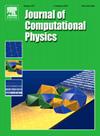A sixth-order finite difference model coupled with the matched interface and boundary method for underwater acoustic propagation simulations
IF 3.8
2区 物理与天体物理
Q2 COMPUTER SCIENCE, INTERDISCIPLINARY APPLICATIONS
引用次数: 0
Abstract
To improve the accuracy of seabed processing in finite difference (FD) models for ocean acoustic field simulations, a nominal fifth-order matched interface and boundary (MIB) method is developed, which can automatically determine the highest achievable order of accuracy near boundaries or complex seabed interfaces. Since the MIB method can separate the discretization of partial differential equations from the implementation of interface conditions, a sixth-order FD scheme is also developed to discretize the acoustic Helmholtz equation coupled with the fifth-order MIB method. This FD scheme is applied to each grid line segment whose end nodes are either the physical boundary nodes or the MIB ghost nodes, and the FD scheme near the MIB ghost nodes is designed to be consistent with that at the boundary nodes. Furthermore, the accuracy of the present FD model has been numerically verified using two- and three-dimensional acoustic benchmarks, including a newly designed C-shaped atoll acoustic propagation case. Compared with the fourth-order FD model using the smoothing approximation method to handle the seabed, which requires a PPW (points per wavelength) of 30∼60 for the accurate computation of a general non-flat ocean acoustic field, the proposed sixth-order FD model coupled with the MIB method requires only a PPW of 8 with the comparable solution accuracy, leading to a significant improvement in the computational efficiency of three-dimensional ocean acoustic field simulations.
求助全文
约1分钟内获得全文
求助全文
来源期刊

Journal of Computational Physics
物理-计算机:跨学科应用
CiteScore
7.60
自引率
14.60%
发文量
763
审稿时长
5.8 months
期刊介绍:
Journal of Computational Physics thoroughly treats the computational aspects of physical problems, presenting techniques for the numerical solution of mathematical equations arising in all areas of physics. The journal seeks to emphasize methods that cross disciplinary boundaries.
The Journal of Computational Physics also publishes short notes of 4 pages or less (including figures, tables, and references but excluding title pages). Letters to the Editor commenting on articles already published in this Journal will also be considered. Neither notes nor letters should have an abstract.
 求助内容:
求助内容: 应助结果提醒方式:
应助结果提醒方式:


